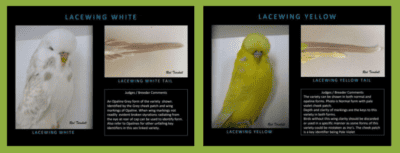
Lacewing Budgerigar/Budgies
The Lacewing budgerigar is a sex-linked variety resulting from the same genetic factor responsible for the Ino (Lutino and Albino) types. This mutation removes melanin, eliminating black pigment in the feathers and eyes. As a result, birds that would typically be green or blue appear as bright yellow (green series) or clear white (blue series), complete with red eyes and a white iris ring.
However, unlike Lutino’s and Albinos, Lacewings feature cinnamon-brown markings on the wings, back of the neck, and tail. They also have pale violet cheek patches and well-defined throat spots, offering a subtle yet elegant contrast to their clear body colour. Lacewings have fleshy pink feet and, in cocks, a matching fleshy pink cere.
History of the Lacewing Mutation
During the Second World War, the Lacewing Budgerigar was being bred in various country areas of Queensland, as indicated by records. In 1959, Mr. Hector Hall of Kingaroy asked Tom Smith, one of the more knowledgeable Queensland fanciers, to visit his aviaries. Mr. Hall had been breeding these birds for the previous ten years but didn’t know what they were. Smith identified them as Lacewings, which had already been reported as a mutation occurring in Britain about 1948. Mr. Hall’s breeding record for the previous five years confirmed Lacewing Budgies are a sex-linked variety.

Image Courtesy of Rod Turnbull and the ANBC
Lacewing Budgerigar/Budgie – Identification
The exhibition Lacewing budgerigar has a general body colour that is solid and uniform throughout the rump and underparts, as stated in The Standard. The back and wing coverts are cinnamon with markings that are symmetrical on the ground color and free of any body color suffusion. The Lacewing features a deep and wide mask that extends beyond two large cheek patches. Six evenly spaced, large, round cinnamon throat spots ornament the mask. In addition, the base of the pale violet cheek patches partially covers the two outer spots.
Meanwhile, markings on the cheeks, back of head, neck, and wings are cinnamon, clearly defined, and symmetrical on the appropriate ground color. They are free from any intrusion of body color or ‘bloom’.
The Lacewing budgerigar features a pale cinnamon tail feather and a neutral tail quill. Its eye is red with a white iris ring, and its feet and legs are pink in color. The cock has a flesh-colored cere, while the hen has a brown cere. Below is a summary of the colors of the Lacewing’s cheek patch, tail quill, and tail feather.

Lacewing Budgerigar/Budgie Pairings
The Lacewing gene is sex-linked, meaning only cocks can carry the gene without visually expressing it. Hens, on the other hand, must be visual Lacewings or not carry the gene at all.

Click here to see pairing expectation in full
Breeding for Exhibition Quality
To produce an exhibition-standard Lacewing budgerigar, breeders must focus on:
- Deep, clear body colour (preferably buttercup yellow or crisp white)
- Strong, defined cinnamon-brown wing and tail markings
- Proper size, deportment, and feather quality
Avoiding body colour suffusion (green or blue tinting) is essential. Many breeders use Grey or Grey Green partners to control this, although overuse can dull the colour. Others introduce dark factor birds to enhance the richness of the yellow.
When it comes to improving wing markings, breeders are divided. Some prefer using Cinnamon partners, while others stick to Normals, believing that Cinnamons may dilute overall contrast.

- Click here to download the pictorial for Lacewing White Budgies
- Click here to download the pictorials for Lacewing Yellow Budgies
